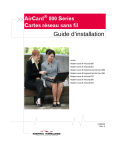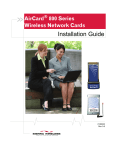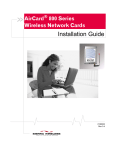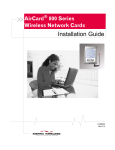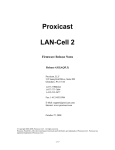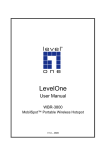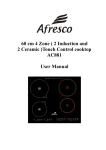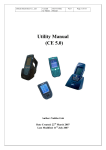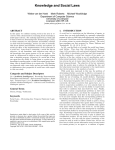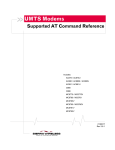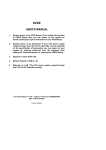Download Siera AirCard 800 Series Installation guide
Transcript
AirCard® 800 Series Wireless Network Cards Installation Guide Includes: AirCard 880 Wireless Modem AirCard 881 Wireless Modem AirCard 880 Express Card Wireless Modem AirCard 881 Express Card Wireless Modem AirCard 875 Wireless Modem AirCard 860 Wireless Modem AirCard 850 Wireless Modem 2130623 Rev 3.8 Limitation of Liability The information in this manual is subject to change without notice and does not represent a commitment on the part of Sierra Wireless or its affiliates. SIERRA WIRELESS AND ITS AFFILIATES SPECIFICALLY DISCLAIM LIABILITY FOR ANY AND ALL DIRECT, INDIRECT, SPECIAL, GENERAL, INCIDENTAL, CONSEQUENTIAL, PUNITIVE OR EXEMPLARY DAMAGES INCLUDING, BUT NOT LIMITED TO, LOSS OF PROFITS OR REVENUE OR ANTICIPATED PROFITS OR REVENUE ARISING OUT OF THE USE OR INABILITY TO USE ANY SIERRA WIRELESS PRODUCT, EVEN IF SIERRA WIRELESS AND/OR ITS AFFILIATES HAVE BEEN ADVISED OF THE POSSIBILITY OF SUCH DAMAGES OR THEY ARE FORESEEABLE OR FOR CLAIMS BY ANY THIRD PARTY. NOTWITHSTANDING THE FOREGOING, IN NO EVENT SHALL SIERRA WIRELESS AND/OR ITS AFFILIATES’ AGGREGATE LIABILITY ARISING UNDER OR IN CONNECTION WITH THE SIERRA WIRELESS PRODUCT, REGARDLESS OF THE NUMBER OF EVENTS, OCCURRENCES OR CLAIMS GIVING RISE TO LIABILITY, BE IN EXCESS OF THE PRICE PAID BY THE PURCHASER FOR THE SIERRA WIRELESS PRODUCT. Patents Portions of this product may be covered by some or all of the following US patents: 5,515,013 5,629,960 5,845,216 5,847,553 5,878,234 5,890,057 5,929,815 6,169,884 6,191,741 6,199,168 6,339,405 6,359,591 6,400,336 6,516,204 6,561,851 6,643,501 6,653,979 6,697,030 6,785,830 6,845,249 6,847,830 6,876,697 6,879,585 6,886,049 6,968,171 6,985,757 7,023,878 7,053,843 7,106,569 D442,170 D459,303 and other patents pending. This product includes technology licensed from: Licensed by QUALCOMM Incorporated under one or more of the following United States patents and/or their counterparts in other nations: 4,901,307 5,056,109 5,101,501 5,109,390 5,228,054 5,267,261 5,267,262 5,337,338 5,414,796 5,416,797 5,490,165 5,504,773 5,506,865 5,511,073 5,535,239 5,544,196 5,568,483 5,600,754 5,657,420 5,659,569 5,710,784 5,778,338 Manufactured or sold by Sierra Wireless or its licensees under one or more patents licensed from InterDigital Group. Copyright Rev 3.8 May.07 © 2007 Sierra Wireless. All rights reserved. 3 AirCard 800 Series Installation Guide Trademarks AirCard modem® and Heart of the Wireless Machine® are registered trademarks of Sierra Wireless. Sierra Wireless, the Sierra Wireless logo, the red wave design, the red‐tipped antenna, and Watcher are trademarks of Sierra Wireless. Other trademarks are the property of the respective owners. All product specifications are subject to change without notice. Contact Information Sales Desk: Phone: 1-604-232-1488 Hours: 8:00 AM to 5:00 PM Pacific Time E-mail: [email protected] Post: Sierra Wireless 13811 Wireless Way Richmond, BC Canada V6V 3A4 Fax: 1-604-231-1109 Web: www.sierrawireless.com Consult our website for up‐to‐date product descriptions, documentation, application notes, firmware upgrades, trouble‐ shooting tips, and press releases: www.sierrawireless.com 4 2130623 Table of Contents Introducing the AirCard 800 Series Wireless Network Cards . . . . . . . . . . . . . .7 AirCard 800 Series wireless network cards . . . . . . . . . . . . . . . . . . . . . . . . . . . . . 7 Services supported . . . . . . . . . . . . . . . . . . . . . . . . . . . . . . . . . . . . . . . . . . . . . . . . . 7 Your account and coverage area. . . . . . . . . . . . . . . . . . . . . . . . . . . . . . . . . . . . . . 8 AirCard modem software . . . . . . . . . . . . . . . . . . . . . . . . . . . . . . . . . . . . . . . . . . . . 9 Frequency band support . . . . . . . . . . . . . . . . . . . . . . . . . . . . . . . . . . . . . . . . . . . . 9 AirCard Installation . . . . . . . . . . . . . . . . . . . . . . . . . . . . . . . . . . . . . . . . . . . . . . . . .11 System requirements . . . . . . . . . . . . . . . . . . . . . . . . . . . . . . . . . . . . . . . . . . . . . . 11 The SIM Card and Your Account . . . . . . . . . . . . . . . . . . . . . . . . . . . . . . . . . . . . 11 Attach the antenna to your AirCard modem . . . . . . . . . . . . . . . . . . . . . . . . . . . 12 Install Watcher software . . . . . . . . . . . . . . . . . . . . . . . . . . . . . . . . . . . . . . . . . . . 13 Setting Internet Explorer to use the AirCard modem . . . . . . . . . . . . . . . . . . . 14 Configuring Your Account . . . . . . . . . . . . . . . . . . . . . . . . . . . . . . . . . . . . . . . . . . 14 Setting up a profile . . . . . . . . . . . . . . . . . . . . . . . . . . . . . . . . . . . . . . . . . . . . . . . . 15 The AirCard modem as a network card . . . . . . . . . . . . . . . . . . . . . . . . . . . . . . . 16 Watcher Basics . . . . . . . . . . . . . . . . . . . . . . . . . . . . . . . . . . . . . . . . . . . . . . . . . . . . .17 Launching Watcher. . . . . . . . . . . . . . . . . . . . . . . . . . . . . . . . . . . . . . . . . . . . . . . . 17 Frequency band selection . . . . . . . . . . . . . . . . . . . . . . . . . . . . . . . . . . . . . . . . . . 18 Care and Maintenance of Your Network Card . . . . . . . . . . . . . . . . . . . . . . . . . .19 Stopping and ejecting the AirCard modem . . . . . . . . . . . . . . . . . . . . . . . . . . . 20 Removing a SIM card . . . . . . . . . . . . . . . . . . . . . . . . . . . . . . . . . . . . . . . . . . . . . . 20 AirCard 850 and 860 modems . . . . . . . . . . . . . . . . . . . . . . . . . . . . . . . . . . . . 20 AirCard 875, 88x, and 88xE modems . . . . . . . . . . . . . . . . . . . . . . . . . . . . . . 21 Rev 3.8 May.07 5 AirCard 800 Series Installation Guide Regulatory and Safety Information . . . . . . . . . . . . . . . . . . . . . . . . . . . . . . . . . . .23 Important notice . . . . . . . . . . . . . . . . . . . . . . . . . . . . . . . . . . . . . . . . . . . . . . . . . . 23 Safety and hazards . . . . . . . . . . . . . . . . . . . . . . . . . . . . . . . . . . . . . . . . . . . . . 23 Important safety/compliance information for North American users. . . . . . 24 Information pertaining to OEM customers . . . . . . . . . . . . . . . . . . . . . . . . . 25 EU regulatory conformity. . . . . . . . . . . . . . . . . . . . . . . . . . . . . . . . . . . . . . . . . . . 27 Technical Specifications . . . . . . . . . . . . . . . . . . . . . . . . . . . . . . . . . . . . . . . . . . . .29 LEDs . . . . . . . . . . . . . . . . . . . . . . . . . . . . . . . . . . . . . . . . . . . . . . . . . . . . . . . . . . . . 29 Radio frequency and electrical specifications . . . . . . . . . . . . . . . . . . . . . . . . . 29 Environmental specifications . . . . . . . . . . . . . . . . . . . . . . . . . . . . . . . . . . . . . . . 30 6 2130623 1: Introducing the AirCard 800 Series 1 Wireless Network Cards • AirCard 800 Series wireless network cards • Your account and coverage area • AirCard modem software Caution: Do not insert your AirCard modem into your PC / Express Card slot before installing the software. AirCard 800 Series wireless network cards The AirCard 800 Series 3G wireless network cards are modems for your PC that allow you to connect to the Internet, send and receive e‐mail, connect to a corporate network/VPN, or view streaming video, without the need of a network cable or phone line. The AirCard PC Card modem (AirCard 850 / 860 / 875 / 88x) fits into a standard (Type II) PC Card slot available on notebook PCs. The AirCard Express Card modem (AirCard 88xE) fits into a standard Express Card‐34 slot available on notebook PCs. Services supported The services supported on your AirCard modem depends on the model of AirCard (see www.sierrawireless.com for details) and your service provider. When establishing a connection, your AirCard modem uses the fastest available service. If, for example, you are using an AirCard modem in an area that has GPRS and EDGE service but not UMTS or HSDPA service, the AirCard modem connects using EDGE service. Once the connection is established, you have access to all Internet services. Rev 3.8 May.07 7 AirCard 800 Series Installation Guide Your account and coverage area Note: If you purchased the AirCard modem from a GSM service provider, you may already have an account. Otherwise, your retailer should be able to provide you with the names of companies that provide this service. You must have an account with a GSM service provider to use the AirCard modem. To use the modem’s 3G capability, your account must be with a service provider who offers HSDPA / HSUPA or UMTS service. (The AirCard modem is backward‐ compatible to 2G service.) When you obtain your account, you are given a SIM card, also called a “smart card” or “smart chip”. (Depending on how you purchased your AirCard modem, you may already have an account, and your SIM card may have been included in your package.) The SIM card contains account information and must be inserted in the AirCard modem anytime you use it. Before you can use the AirCard modem, you must install the AirCard modem software and ensure that your AirCard modem is configured to use your account. Once the AirCard modem is installed and configured, you can connect to the Internet with the AirCard modem in any area in which you can obtain GPRS, EDGE, UMTS, or HSDPA / HSUPA service. Your ability to obtain service depends on these factors: Note: The fee for service is usually higher when you are “roaming” (connected to a network other than the one belonging to your service provider). • Proximity to a GSM network—You must be within the coverage area of a GSM network in order to use the AirCard modem. • Service provider—If you are within the coverage area of a network that is not operated by your own service provider, you can only obtain service if there is a roaming agreement between your service provider and the network operator. • Account provisions—Your account may restrict your usage to certain networks or limit the amount of time you can use the network. • Frequency band—You cannot connect to networks operating in bands not supported by your AirCard modem, regardless of roaming agreements or account provisions. Most service providers have coverage maps on their web sites. 8 2130623 AirCard modem software AirCard modem software The AirCard modem comes with this software (made by Sierra Wireless): • The Watcher program that you use to manage the AirCard modem and monitor your connections • The driver software that forms the interface between the network card and your Windows operating system Frequency band support The following table shows the frequency bands supported by the various AirCard products Table 1-1: Frequency band support Technology 2G 3G Bands Products Location 850 MHz (cellular band) All North America 900 MHz All Europe 1800 MHz All Europe and Asia 1900 MHz (PSC band) All North America WCDMA 850ab AirCard88x AirCard88xE AirCard875 AirCard860 North America WCDMA 1900b AirCard88x AirCard88xE AirCard875 AirCard860 North America WCDMA 2100a AirCard88x AirCard88xE AirCard875 AirCard850 Europe, Asia, and Australia a. Receive diversity (AirCard 880 and 880E) b. Receive diversity (AirCard 881 and 881E) Rev 3.8 May.07 9 AirCard 800 Series Installation Guide 10 2130623 2: AirCard Installation • System requirements • Install Watcher software • Setting Internet Explorer to use the AirCard modem 2 System requirements The AirCard modem is supported on: • Windows® Vista™ • Windows XP (Home and Professional versions) • Windows 2000 For information on using the AirCard modem with other operating systems, contact Sierra Wireless Technical Support ([email protected]). To install the AirCard modem, you require these system resources: Table 2-1: System resource requirements Card slots 1 Type II PCMCIA (PC Card) slot for AirCard 850, 860, 875, 88x 1 Express Card-34 slot for AirCard 88xE Disk drive CD-ROM I/O resources 1 IRQ, 40 bytes I/O space Memory 32 MB The SIM Card and Your Account To use your AirCard modem, you need a GSM account and a SIM (Subscriber Identity Module) card. The SIM card is a small chip (about the size of a postage stamp) that you insert into the AirCard modem. The SIM contains account information used by the network to validate your access. Note: Without a valid SIM card and a valid account, your AirCard modem will not work. Rev 3.8 May.07 Depending on how you purchased your AirCard modem, you may already have an account. In this case, the SIM should be included in your package. Otherwise, your retailer should direct you to a local company that provides GSM service. 11 AirCard 800 Series Installation Guide To activate an account, the service provider needs from you: Note: Keep a written record, in a secure place, of the account information that your service provider gives you. Instructions on creating a profile are in the section “Configuring Your Account” on page 14. • Billing information (such as a credit card number) used to collect payment for your network usage • Possibly the IMEI (International Mobile Equipment Identity), depending on your service provider. This number, printed on the AirCard modem box and on the AirCard modem label, identifies your device (AirCard modem model) on the GSM network. If you change GSM service providers (such as if you move to a new city), you will need a new SIM card from your new service provider. You will also need to set up a new profile. Attach the antenna to your AirCard modem Note: This section applies only to the AirCard 850 modem and AirCard 860 modem. If your AirCard modem has an external antenna, the antenna attaches to the gold‐plated connector on the end of the AirCard modem. Figure 2-1: Attaching the antenna to the AirCard modem 12 2130623 Install Watcher software Install Watcher software Note: Users of Windows 2000 must be logged in with administrative privileges. Users of Windows XP may require administrative privileges. Note: If you are running Windows 2000, Windows Installer Redistributable 2.0 must be installed. This is available on the Microsoft web site, www.microsoft.com. Note: You may require your Windows CD. Ensure you have the CD before proceeding. 1. If the AirCard modem CD is not already in your CD‐ROM drive, insert it. The CD should autostart and display a menu. If the CD does not autostart, select Start > Run and enter d:\setup.exe where d is the drive letter of your CD‐ROM drive. 2. From the CD start‐up menu, select your language, then notebook installation, and then the link under notebook software installation to launch the installer. 3. Use the Next and Back buttons to navigate through the installer. 4. If the SIM is not already inserted in your AirCard modem, insert it. 5. For the AirCard 850 modem / AirCard 860 modem: If the antenna is not yet attached, attach it. (See page 12.) 6. With the label facing up, insert the AirCard modem into your PC / Express Card slot. Note: Do not forcefully insert the AirCard modem. This may damage connector pins. If you have more than one PC / Express Card slot, you may obtain better signal strength using the top slot. Figure 2-2: Inserting the AirCard modem To close the CD start‐up menu, click the exit option in the lower right corner of the window. Rev 3.8 May.07 13 AirCard 800 Series Installation Guide Watcher should launch automatically when the AirCard modem is inserted. If your AirCard modem has not yet been configured to use your account, you are prompted to do so. See “Setting up a profile” on page 15. Setting Internet Explorer to use the AirCard modem If you are using Internet Explorer as your browser, and it is set to connect to the Internet through a dial‐up modem, you must set it to use a LAN (local area network) card. To set Internet Explorer version 5 or 6 to use a LAN, follow these steps: 1. In Internet Explorer, select Tools > Internet Options. 2. Click the Connections tab. 3. Click Setup to run the Internet Connection wizard. 4. Select the option “I want to set up my Internet connection manually, or I want to connect through a local area network (LAN).” Click Next. 5. Select “I connect through a local area network (LAN)”. Click Next. 6. Ensure no check boxes are selected in the “Local area network Internet configuration” window and click Next. 7. Select No when prompted to set up an Internet mail account and click Next. 8. Click Finish to exit the wizard. Configuring Your Account Profiles contain account information used by the AirCard modem to establish connections. At least one profile must be set up on the AirCard modem before you can use it. The profile(s) may have been stored on the AirCard modem before you purchased it. Otherwise, your service provider should give you all the information you need to set up the profile(s) you require. Depending on your service provider, some or all of this infor‐ mation must be entered into your profile: 14 • User Name • Password • APN (Access Point Name) 2130623 Setting up a profile • IP (Internet Protocol) Address (if the address is not automatically assigned by the network) • Use of IP header compression • DNS (Domain Name Server) address or addresses Your service provider may give you only one APN in which case you require only one profile. Some service providers assign separate APNs for separate purposes. For example, some service providers supply one APN to use for Internet browsing and a different APN to use with a VPN. In this case you must set up multiple profiles. The AirCard modem allows for up to sixteen profiles. Most service providers have one or two standard profiles that all or most of their subscribers are expected to use. Most of these standard profiles have been pre‐defined in Watcher, allowing you to select a standard profile, rather than creating it manually. One of your profiles must be set as the “default” profile. This is the one that is used if you select the Connect button without selecting a profile. The default profile is also used if you set the AirCard modem to autoconnect. If you are using the AirCard modem to access a network that requires you to provide a password each time you connect, you must set the connection mode for your profile to prompt for password (in which case you must connect manually). Setting up a profile Note: You must install the software before you can set up a profile. (See page 11.) 1. Insert the SIM into the AirCard modem if it is not already inserted. 2. Insert the AirCard modem into the PC / Express Card slot if it is not already inserted. (See page 13.) 3. If Watcher is not running, start Watcher by selecting Start > Programs > Sierra Wireless >3G Watcher > 3G Watcher or double‐clicking the desktop shortcut . If Watcher detects that no profile has been set up, you are prompted, “Would you like to configure a profile now?” Select Yes. If this prompt does not appear, your AirCard modem may have been preconfigured. You can verify that you have a profile by selecting Tools > Connections to access the AirCard modem tab of the Connections window, which lists all profiles. Rev 3.8 May.07 15 AirCard 800 Series Installation Guide The AirCard modem as a network card The AirCard modem can be configured to provide the “always‐on” data connection that an Ethernet card or other wired LAN card provides. That is, you can set options in Watcher™ (a program that comes with the AirCard modem) that causes the AirCard modem to establish a network connection whenever you insert it, assuming GSM, GPRS, EDGE, UMTS, or HSDPA service is available. Otherwise, you can configure Watcher to connect only when you click the Connect button. The AirCard modem connection provides access to the Internet. Once the connection is established, you can open your browser and connect to any web site available on the Internet, or access other Internet services (such as e‐mail). 16 2130623 3: Watcher Basics • Launching Watcher • Frequency band selection Note: It takes up to 20 seconds for Watcher to become fully functional after launch. 3 Watcher is the program you use to manage and monitor your AirCard modem connections. Watcher allows you to: • Create an account profile. • Determine signal strength, roaming status, GPRS / EDGE / UMTS / HSDPA / HSUPA availability, and other network connection parameters • Monitor the status of the AirCard modem and GSM service • Initiate data connections • Make and receive phone calls • Send and receive SMS messages • Enable or disable SIM security that prevents others from using your SIM card if it is lost or stolen • Set options related to notifications and the Watcher window If you set your account profile to autoconnect, you do not need to run Watcher when you use the AirCard modem, but Watcher does provide useful status information. Launching Watcher Unless the feature has been disabled, Watcher launches automatically anytime you insert the AirCard modem. You can also launch Watcher by: • • Double‐clicking the desktop shortcut, or Selecting Start > Programs > Sierra Wireless > 3G Watcher > Watcher Depending on how your profile is configured, your browser, VPN, or other program may launch automatically anytime you launch Watcher. To view the 3G Watcher online help, press <F1> or select Help > Help Topics. Rev 3.8 May.07 17 AirCard 800 Series Installation Guide Frequency band selection Watcher has two options that affect your ability to obtain GPRS, EDGE, UMTS, or HSDPA service in any given area. You can select: • The frequency band you want to use • The network you want to use, if you are within the coverage area of more than one network Every GSM network operates on one set of frequency bands. The AirCard modem is designed to change frequency bands automatically as required to obtain network service. You can also change frequency bands manually from the Network tab of the Options window (Tools > Options... > Network). Note: Unless your service provider specifies otherwise, it is recommended that you use the Auto setting. 18 2130623 4: Care and Maintenance of Your Network Card 4 You can ensure reliable operation and long life of your AirCard modem by adhering to these guidelines in storage and use: Note: Do not insert the AirCard modem before installing the software. See “AirCard Installation” on page 11. Protect the card from liquids, dust, and excessive heat (see “Environmental specifications” on page 30 for details). • Do not apply adhesive labels to the AirCard modem or SIM. This may cause the AirCard modem or SIM to become jammed inside the slot, or prevent it from being inserted properly. • When not installed in your computer, store the AirCard modem and SIM in a safe place. • The AirCard modem should fit easily into your computer’s PC / Express Card slot. Forcing the AirCard modem into the slot may damage the connector pins. • For AirCard modems with external antennas, optimal signal strength is usually obtained when the antenna is pointing straight up. The antenna should bend easily at the hinge. Do not forcefully bend the antenna. Figure 4-1: Proper positioning of the AirCard modem antenna for AirCard 850 modem / AirCard 860 modem Rev 3.8 May.07 19 AirCard 800 Series Installation Guide Stopping and ejecting the AirCard modem To remove the AirCard modem: 1. Close Watcher if it is open. 2. Click the PC Card icon in the status area to display the option to stop the card. 3. Click the appropriate option, depending on your operating system and the model of AirCard modem. 4. If a dialog box appears notifying you that it is safe to remove the card, click OK. Push the PC Card eject button beside the PC / Express Card slot on your computer to eject the card. 5. 6. Grasp the AirCard modem and remove it from the slot. Removing a SIM card The procedure for removing the SIM card depends on the model of AirCard modem you have. AirCard 850 and 860 modems To remove the SIM card, you need a pen. 20 1. Place the AirCard modem on a smooth, hard surface such as a tabletop. 2. Position the pen above the eject hole, which is on the top surface of the AirCard modem housing, just to the right of the SIM card slot. (See Figure 4‐2.) 3. Press down gently (without excessive force) on the eject hole. The SIM card should pop out of its slot. 2130623 Removing a SIM card Figure 4-2: Ejecting the SIM card 4. Gently pull the SIM card from the slot until it slides free. AirCard 875, 88x, and 88xE modems To remove the SIM/USIM card, you need a pen. 1. Place the AirCard modem on a smooth, hard surface such as a tabletop, or hold it face down. 2. Gently insert the pen into the end of the eject slot farthest from the SIM slot. Slide the pen towards the SIM slot. The SIM card pops out of its slot. Figure 4-3: Ejecting the SIM card 3. Rev 3.8 May.07 Gently pull the SIM card from the slot until it slides free. 21 AirCard 800 Series Installation Guide 22 2130623 5: Regulatory and Safety Information • Important notice • Important safety/ compliance information for North American users • EU regulatory conformity 5 Important notice Because of the nature of wireless communications, trans‐ mission and reception of data can never be guaranteed. Data may be delayed, corrupted (that is, have errors) or be totally lost. Although significant delays or losses of data are rare when wireless devices such as the Sierra Wireless network card are used in a normal manner with a well‐constructed network, the Sierra Wireless network card should not be used in situations where failure to transmit or receive data could result in damage of any kind to the user or any other party, including but not limited to personal injury, death, or loss of property. Sierra Wireless and its affiliates accept no responsi‐ bility for damages of any kind resulting from delays or errors in data transmitted or received using the Sierra Wireless network card, or for failure of the Sierra Wireless network card to transmit or receive such data. Safety and hazards Do not operate your AirCard modem: • In areas where blasting is in progress • Where explosive atmospheres may be present including refuelling points, fuel depots, and chemical plants • Near medical equipment • Near life support equipment, or any equipment which may be susceptible to any form of radio interference. In such areas, the AirCard modem MUST BE POWERED OFF. Otherwise, the AirCard modem can transmit signals that could interfere with this equipment. In an aircraft, the AirCard modem MUST BE POWERED OFF. Otherwise, the AirCard modem can transmit signals that could interfere with various onboard systems and may be dangerous to the operation of the aircraft or disrupt the cellular network. Use of a cellular phone in an aircraft is illegal in some jurisdi‐ Rev 3.8 May.07 23 AirCard 800 Series Installation Guide cations. Failure to observe this instruction may lead to suspension or denial of cellular telephone services to the offender, or legal action or both. Some airlines may permit the use of cellular phones while the aircraft is on the ground and the door is open. The AirCard modem may be used normally at this time. Important safety/compliance information for North American users CAUTION: Unauthorized modifications or changes not expressly approved by Sierra Wireless, Inc. could void compliance with regulatory rules, and thereby your authority to use this equipment. The design of the AirCard 850 / 860 / 875 / 880 / 881 / 880E / 881E modem complies with U.S. Federal Communications Commission (FCC) and Industry Canada (IC) guidelines respecting safety levels of radio frequency (RF) exposure for portable devices, which in turn are consistent with the following safety standards previously set by Canadian, U.S. and international standards bodies: • ANSI / IEEE C95.1‐1999, IEEE Standard for Safety Levels with Respect to Human Exposure to Radio Frequency Electro‐ magnetic Fields, 3kHz to 300 GHz • National Council on Radiation Protection and Measure‐ ments (NCRP) Report 86, ‐1986, Biological Effects and Exposure Criteria for Radio Frequency Electromagnetic Fields • Health Canada, Safety Code 6, 1999, Limits of Human Exposure to Radio frequency Electromagnetic Fields in the Frequency Range from 3 kHz to 300 GHz • International Commission on Non‐Ionising Radiation Protection (ICNIRP) 1998, Guidelines for limiting exposure to time‐varying electric, magnetic, and electromagnetic fields (up to 300 GHz) These devices are only authorized to be used in laptop computers that are identical or substantially similar to those in its grant application. These devices comply with Part 15 of the FCC Rules. Operation is subject to the condition that these devices do not cause harmful interference. 24 2130623 Regulatory and Safety Information Where appropriate, the use of the equipment is subject to the following conditions: WARNING (EMI) – United States FCC Information – This equipment has been tested and found to comply with the limits pursuant to Part 15 of the FCC Rules. These limits are designed to provide reasonable protection against harmful interference in an appropriate installation. This equipment generates, uses, and can radiate radio frequency energy and, if not installed and used in accordance with the instructions, may cause harmful interference to radio communication. However, there is no guarantee that interference will not occur in a particular installation. If this equipment does cause harmful interference to radio or television reception, which can be determined by turning the equipment off and on, the user is encouraged to try to correct the interference by one or more of the following measures: • Reorient or relocate the receiving antenna • Increase the separation between the equipment and receiver • Connect the equipment into an outlet on a circuit different from that to which the receiver is connected • Consult the dealer or an experienced radio/TV technician for help If you have purchased this product under a United States Government contract, it shall be subject to restrictions as set forth in subparagraph (c)(1)(ii) of Defense Federal Acquisitions Regulations (DFARs) Section 252.227‐7013 for Department of Defense contracts, and as set forth in Federal Acquisitions Regulations (FARs) Section 52.227‐19 for civilian agency contracts or any successor regulations. If further government regulations apply, it is your responsibility to ensure compliance with such regulations. Information pertaining to OEM customers The AirCard 850 / 860 / 875 / 880 / 881 / 880E / 881E wireless network cards have been granted modular approval for mobile applications. Integrators may use the AirCard 850 / 860 / 875 / 880 / 881 / 880E / 881E wireless network cards in their final products without additional FCC / IC certification if they meet the following conditions. Otherwise, additional FCC / IC approvals must be obtained. Rev 3.8 May.07 1. At least 20 cm separation distance between the antenna and the user’s body must be maintained at all times. 2. The AirCard 850 / 860 / 875 / 880 / 881 / 880E / 881E wireless network cards and their antennas must not be 25 AirCard 800 Series Installation Guide colocated with any other transmitter or antenna within a host device. 3. A user manual with the end product must clearly indicate the operating requirements and conditions that must be observed to ensure compliance with current FCC / IC RF exposure guidelines. 4. The end product with an embedded AirCard 850 / 860 / 875 /880 / 881 / 880E / 881E wireless network card must pass the unintentional emission testing and properly authorized per FCC Part 15 requirements where appli‐ cable. Note: If these wireless network cards are intended for use in a portable device, you are responsible for separate approval to satisfy the SAR requirements of FCC Part 2.1093 and IC RSS-102. AirCard 850 / 860 wireless network cards 1. To comply with FCC / IC regulations limiting both maximum RF output power and human exposure to RF radiation, the maximum antenna gain must not exceed 8 dBi in the Cellular band and 4 dBi in the PCS band. 2. A label must be affixed to the outside of the end product into which the AirCard wireless network card is incorpo‐ rated, with a statement similar to the following: • For an end product with an embedded AirCard 850 wireless network card: This device contains FCC ID: N7NAC850. • For an end product with an embedded AirCard 860 wireless network card: This device contains FCC ID: N7NAC860. This equipment contains equipment certified under IC: 2417C‐AC860. AirCard 875 / 880 / 881 / 880E / 881E 1. To comply with FCC / IC regulations limiting both maximum RF output power and human exposure to RF radiation, the maximum antenna gain must not exceed 5 dBi in the Cellular band and 4 dBi in the PCS band. 2. A label must be affixed to the outside of the end product into which the AirCard wireless network card is incorpo‐ rated, with a statement similar to the following: • For an end product with an embedded AirCard 875 wireless network card: This device contains FCC ID: N7NAC875. 26 2130623 Regulatory and Safety Information This equipment contains equipment certified under IC: 2417C‐AC875. • For an end product with an embedded AirCard 880 wireless network card: This device contains FCC ID: N7NAC880. • For an end product with an embedded AirCard 881 wireless network card: This device contains FCC ID: N7NAC881. This equipment contains equipment certified under IC: 2417C‐AC881. • For an end product with an embedded AirCard 880E Express Card wireless network card: • For an end product with an embedded AirCard 881E Express Card wireless network card: This device contains FCC ID: N7NAC880E. This device contains FCC ID: N7NAC881E. This equipment contains equipment certified under IC: 2417C‐AC881E. EU regulatory conformity Sierra Wireless hereby declares that the AirCard 850 / 875 / 880 / 880E wireless network cards conform to all the essential requirements of Directive 1999/5/EC: AirCard 875 and AirCard 880 Wireless Network Card AirCard 880E Express Card AirCard 850 Wireless Network Card The Declaration of Conformity made under Directive 1999/5/ EC is available for viewing at the following location in the EU community: Sierra Wireless (UK), Limited Lakeside House 1 Furzeground Way, Stockley Park East Uxbridge, Middlesex UB11 1BD England Rev 3.8 May.07 27 AirCard 800 Series Installation Guide 28 2130623 6: Technical Specifications 6 This chapter provides technical data for the AirCard modem. LEDs For a description of LED functionality, see the 3G Watcher online help. Radio frequency and electrical specifications Table 6-1: Radio frequency and electrical specifications for AirCard 850 / 860 /875 modems Compliance GSM Release 5 Transmit PCS: 1850 to 1910 MHz DCS1800: 1710 to 1785 MHz EGSM900: 880 to 915 MHz GSM850: 824 to 849 MHz WCDMA2100: (AirCard 850, 875, 88x, 88xE modems) 1920 to 1980 MHz WCDMA850: (AirCard 850, 875, 88x, 88xE modems) 824 to 849 MHz WCDMA1900: (AirCard 850, 875, 88x, 88xE modems) 1850 to 1910 MHz Receive PCS: 1930 to 1990 MHz DDCS1800: 1805 to 1880 MHz EGSM900: 925 to 960 MHz GSM850: 869 to 894 MHz WCDMA2100: (AirCard 850, 875, 88x, 88xE modems) 2110 to 2170 MHz WCDMA850: (AirCard 850, 875, 88x, 88xE modems) 869 to 894 MHz WCDMA1900: (AirCard 850, 875, 88x, 88xE modems) 1930 to 1990 MHz Channel spacing 200 kHz (GSM) 5 MHz (WCDMA) Channel raster 200 kHz Rev 3.8 May.07 29 AirCard 800 Series Installation Guide Table 6-1: Radio frequency and electrical specifications for AirCard 850 / 860 /875 modems (cont.) Frequency stability 0.1 ppm Environmental specifications Table 6-2: Environmental specifications 30 Operating temperature -20°C to +60°C (-4°F to +140°F) Storage temperature -30°C to +85°C (-22°F to +185°F) Humidity 95%, non-condensing Vibration 15 g peak 10 to 2000 Hz (non-operating) 2130623 Index A IRQ (interrupt request) 11 account 8 always‐on data connection 16 antenna attaching 12, 13 APN 14 L C care and maintenance 19 channel raster 29 channel spacing 29 copyright information 3 coverage area 8 D DNS 14 driver 9 launching Watcher 17 LEDs 29 liability, limitation of 3 M maintenance 19 memory required 11 N network overview 8 notebook PC inserting AirCard modem 13 removing the AirCard modem 20 system requirements 11 E ejecting a SIM card 20, 21 ejecting the AirCard modem 20 electrical specifications 29 environmental specifications 30 F frequencies receive 29 transmit 29 frequency bands selection 18 frequency stability 30 H humidity 30 I I/O space (input/output space) 11 IMEI 12 inserting AirCard modem Windows 98, 2000, Me 13 installation 13–14 Internet Explorer, setting to use the card 14 IP address 14 Rev 3.8 May.07 P password overview 14 PC / Express Card slots required 11 profile default 15 determining if one is set up 15 overview 14 R radio frequency specifications 29 receive frequencies 29 regulatory information 23 removing AirCard modem 20 SIM card 20, 21 RF specifications 29 roaming 8 S safety notice 23 SIM card removing 20, 21 specifications 29–30 electrical 29 environmental 30 31 AirCard 800 Series Installation Guide radio frequency 29 storage temperature 30 when not using card 19 system requirements, notebook PCs 11 V T Watcher introduction 17 launching 17 Windows 2000 as a supported operating system, service pack 11 inserting the card 13 Windows 98 as a supported operating system 11 inserting AirCard modem 13 Windows Me inserting the card 13 technical specifications 29–30 temperature 30 trademarks 4 transmit frequencies 29 U user name 14 32 vibration 30 W 2130623


































